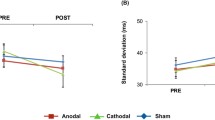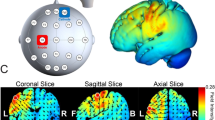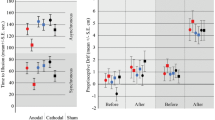Abstract
Perceiving the sensory consequences of one’s own actions is essential to successfully interact with the environment. Previous studies compared self- (active) and externally generated (passive) movements to investigate the processing of voluntary action–outcomes. Increased temporal binding (intentional binding) as well as increased detection of delays between action and outcome have been observed for active compared to passive movements. Using transcranial direct stimulation (tDCS) it has been shown that left hemispheric anodal stimulation decreased the intentional binding effect. However, whether the left hemisphere contributes to delay detection performance between action and outcome is unknown. We investigated polarization-dependent effects of left and right frontoparietal tDCS on detecting temporal action–outcome discrepancies. We applied anodal and cathodal stimulation to frontal (F3/F4), parietal (CP3/CP4) and frontoparietal (F3/CP4) areas. After stimulation, participants were presented with visual feedback with various delays after a key press. They had to report whether they detected a delay between the key press and the feedback. In half of the trials the key press was self-initiated, in the other half it was externally generated. A main effect of electrode location indicated highest detection performance after frontal stimulation. Furthermore, we found that the advantage for active versus passive conditions was larger for left hemispheric anodal stimulation as compared to cathodal stimulation. Whereas the frontal cortex is related to delay detection performance in general, hemispheric differences seem to support the differentiation of self-initiated versus externally generated movement consequences.





Similar content being viewed by others
References
Backasch B, Sommer J, Klöhn-Saghatolislam F, Müller MJ, Kircher TT, Leube DT (2014) Dysconnectivity of the inferior frontal gyrus: implications for an impaired self-other distinction in patients with schizophrenia. Psychiatry Res 223:202–209. doi:10.1016/j.pscychresns.2014.05.007
Blakemore SJ, Wolpert DM, Frith CD (1998) Central cancellation of self-produced tickle sensation. Nat Neurosci 1:635–640. doi:10.1038/2870
Blakemore SJ, Wolpert DM, Frith CD (1999) The cerebellum contributes to somatosensory cortical activity during self-produced tactile stimulation. Neuroimage 10:448–459. doi:10.1006/nimg.1999.0478
Blakemore SJ, Wolpert D, Frith C (2000) Why can’t you tickle yourself? NeuroReport 11:R11–R16
Blakemore SJ, Frith CD, Wolpert DM (2001) The cerebellum is involved in predicting the sensory consequences of action. NeuroReport 12:1879–1884
Brainard DH (1997) The psychophysics toolbox. Spat Vis 10:433–436. doi:10.1163/156856897X00357
Cavazzana A, Penolazzi B, Begliomini C, Bisiacchi PS (2015) Neural underpinnings of the ‘agent brain’: new evidence from transcranial direct current stimulation. Eur J Neurosci 42:1889–1894. doi:10.1111/ejn.12937
David N, Cohen MX, Newen A, Bewernick BH, Shah NJ, Fink GR, Vogeley K (2007) The extrastriate cortex distinguishes between the consequences of one’s own and others’ behavior. Neuroimage 36:1004–1014. doi:10.1016/j.neuroimage.2007.03.030
Dockery CA, Hueckel-Weng R, Birbaumer N, Plewnia C (2009) Enhancement of planning ability by transcranial direct current stimulation. J Neurosci 29:7271–7277 (29/22/7271)
Douglas ZH, Maniscalco B, Hallett M, Wassermann EM, He BJ (2015) Modulating conscious movement intention by noninvasive brain stimulation and the underlying neural mechanisms. J Neurosci 35:7239–7255. doi:10.1523/JNEUROSCI.4894-14.2015
Dundas JE, Thickbroom GW, Mastaglia FL (2007) Perception of comfort during transcranial DC stimulation: effect of NaCl solution concentration applied to sponge electrodes. Clin Neurophysiol 118:1166–1170 (S1388-2457(07)00030-2)
Farrer C, Franck N, Georgieff N, Frith CD, Decety J, Jeannerod M (2003) Modulating the experience of agency: a positron emission tomography study. Neuroimage 18:324–333
Farrer C, Frey SH, Van Horn JD, Tunik E, Turk D, Inati S, Grafton ST (2008) The angular gyrus computes action awareness representations. Cereb Cortex 18:254–261. doi:10.1093/cercor/bhm050
Fründ I, Haenel NV, Wichmann FA (2011) Inference for psychometric functions in the presence of nonstationary behavior. J Vis 11. doi:10.1167/11.6.16
Gandiga PC, Hummel FC, Cohen LG (2006) Transcranial DC stimulation (tDCS): a tool for double-blind sham-controlled clinical studies in brain stimulation. Clin Neurophysiol 117:845–850 (S1388-2457(05)00507-9)
Haggard P, Clark S, Kalogeras J (2002) Voluntary action and conscious awareness. Nat Neurosci 5:382–385. doi:10.1038/nn827
Hashimoto Y, Sakai KL (2003) Brain activations during conscious self-monitoring of speech production with delayed auditory feedback: an fMRI study. Hum Brain Mapp 20:22–28. doi:10.1002/hbm.10119
Hecht D, Walsh V, Lavidor M (2013) Bi-frontal direct current stimulation affects delay discounting choices. Cogn Neurosci 4:7–11. doi:10.1080/17588928.2011.638139
Hughes G, Desantis A, Waszak F (2013) Mechanisms of intentional binding and sensory attenuation: the role of temporal prediction, temporal control, identity prediction, and motor prediction. Psychol Bull 139:133–151. doi:10.1037/a0028566
Iyer MB, Mattu U, Grafman J, Lomarev M, Sato S, Wassermann EM (2005) Safety and cognitive effect of frontal DC brain polarization in healthy individuals. Neurology 64:872–875 (64/5/872)
Javadi AH (2015) Modulation of the pre-supplementary motor area reduces the sense of agency (Commentary on Cavazzana et al.). Eur J Neurosci 42:1887–1888. doi:10.1111/ejn.12954
Khalighinejad N, Haggard P (2015) Modulating human sense of agency with non-invasive brain stimulation. Cortex 69:93–103. doi:10.1016/j.cortex.2015.04.015
Khalighinejad N, Di Costa S, Haggard P (2016) Endogenous action selection processes in dorsolateral prefrontal cortex contribute to sense of agency: a meta-analysis of tDCS studies of ‘intentional binding’. Brain Stimul 9:372–379. doi:10.1016/j.brs.2016.01.005
Kurayama T, Matsuzawa D, Komiya Z, Nakazawa K, Yoshida S, Shimizu E (2012) P50 suppression in human discrimination fear conditioning paradigm using danger and safety signals. Int J Psychophysiol 84:26–32. doi:10.1016/j.ijpsycho.2012.01.004
Leube DT, Knoblich G, Erb M, Grodd W, Bartels M, Kircher TT (2003) The neural correlates of perceiving one’s own movements. Neuroimage 20:2084–2090 (S1053811903004695)
Leube D, Whitney C, Kircher T (2008) The neural correlates of ego-disturbances (passivity phenomena) and formal thought disorder in schizophrenia. Eur Arch Psychiatry Clin Neurosci 258(Suppl 5):22–27. doi:10.1007/s00406-008-5017-z
Leube DT, Knoblich G, Erb M, Schlotterbeck P, Kircher TT (2010) The neural basis of disturbed efference copy mechanism in patients with schizophrenia. Cogn Neurosci 1:111–117. doi:10.1080/17588921003646156
Moore JW, Obhi SS (2012) Intentional binding and the sense of agency: a review. Conscious Cogn 21:546–561. doi:10.1016/j.concog.2011.12.002
Nelson JT, McKinley RA, Golob EJ, Warm JS, Parasuraman R (2014) Enhancing vigilance in operators with prefrontal cortex transcranial direct current stimulation (tDCS). Neuroimage 85(Pt 3):909–917. doi:10.1016/j.neuroimage.2012.11.061
Nitsche MA, Paulus W (2000) Excitability changes induced in the human motor cortex by weak transcranial direct current stimulation. J Physiol 527(Pt 3):633–639 (PHY_1055)
Nitsche MA, Paulus W (2001) Sustained excitability elevations induced by transcranial DC motor cortex stimulation in humans. Neurology 57:1899–1901
Nitsche MA, Liebetanz D, Lang N, Antal A, Tergau F, Paulus W (2003) Safety criteria for transcranial direct current stimulation (tDCS) in humans. Clin Neurophysiol 114:2220–2222 (author reply 2222-2223: S1388245703002359)
Palm U, Feichtner KB, Hasan A et al (2014) The role of contact media at the skin-electrode interface during transcranial direct current stimulation (tDCS). Brain Stimul 7:762–764. doi:10.1016/j.brs.2014.06.006
Poreisz C, Boros K, Antal A, Paulus W (2007) Safety aspects of transcranial direct current stimulation concerning healthy subjects and patients. Brain Res Bull 72:208–214 (S0361-9230(07)00011-1)
Pynn LK, DeSouza JF (2013) The function of efference copy signals: implications for symptoms of schizophrenia. Vis Res 76:124–133. doi:10.1016/j.visres.2012.10.019
Rohde M, Ernst MO (2012) To lead and to lag—forward and backward recalibration of perceived visuo-motor simultaneity. Front Psychol 3:599. doi:10.3389/fpsyg.2012.00599
Schülke R, Straube B (2017) Modulating the assessment of semantic speech-gesture relatedness via transcranial direct current stimulation of the left frontal cortex. Brain Stimul 10:223–230. doi:10.1016/j.brs.2016.10.012
Slutsky DA, Recanzone GH (2001) Temporal and spatial dependency of the ventriloquism effect. NeuroReport 12:7–10
Spitoni GF, Pireddu G, Cimmino RL et al (2013) Right but not left angular gyrus modulates the metric component of the mental body representation: a tDCS study. Exp Brain Res 228:63–72. doi:10.1007/s00221-013-3538-9
Stein BE, Meredith MA (1993) The merging of the senses. The MIT Press, Cambridge
Stoeckel MC, Weder B, Binkofski F et al (2004) Left and right superior parietal lobule in tactile object discrimination. Eur J Neurosci 19:1067–1072
Straube B, Wolk D, Chatterjee A (2011) The role of the right parietal lobe in the perception of causality: a tDCS study. Exp Brain Res 215:315–325. doi:10.1007/s00221-011-2899-1
Straube B, van Kemenade BM, Arikan BE, Fiehler K, Leube DT, Harris LR, Kircher T (2017) Predicting the multisensory consequences of one’s own action: BOLD suppression in auditory and visual cortices. PLoS One 12:e0169131. doi:10.1371/journal.pone.0169131
van Kemenade BM, Arikan BE, Kircher T, Straube B (2016) Predicting the sensory consequences of one’s own action: first evidence for multisensory facilitation. Atten Percept Psychophys. doi:10.3758/s13414-016-1189-1
van Kemenade BM, Arikan EA, Kircher T, Straube B (2017) The angular gyrus is a supramodal comparator area in action-outcome monitoring. Brain Struct Funct. doi:10.1007/s00429-017-1428-9 (in press) (epub ahead of print)
Vroomen J, Keetels M (2006) The spatial constraint in intersensory pairing: no role in temporal ventriloquism. J Exp Psychol Hum Percept Perform 32:1063–1071. doi:10.1037/0096-1523.32.4.1063
Vroomen J, Keetels M (2010) Perception of intersensory synchrony: a tutorial review. Atten Percept Psychophys 72:871–884. doi:10.3758/APP.72.4.871
Wallace MT, Stevenson RA (2014) The construct of the multisensory temporal binding window and its dysregulation in developmental disabilities. Neuropsychologia 64:105–123. doi:10.1016/j.neuropsychologia.2014.08.005
Woods AJ, Antal A, Bikson M et al (2016) A technical guide to tDCS, and related non-invasive brain stimulation tools. Clin Neurophysiol 127:1031–1048. doi:10.1016/j.clinph.2015.11.012
Acknowledgements
We thank Caro Wittke, Christina Schmitter and Leona Hömberg for their help with the data collection. Raw data are available at https://doi.org/10.5281/zenodo.836473.
Author information
Authors and Affiliations
Corresponding author
Ethics declarations
Funding
This work was supported by a research Grant from the University Medical Centre Giessen and Marburg (UKGM; Project Number 25/2015MR) and the German Research Foundation (SFB/TRR 135, Project A3, A5). Benjamin Straube is supported by the German Research Foundation (DFG; Project Numbers STR 1146/8-1 and STR 1146/9-1).
Conflict of interest
The authors have no conflicts of interest to declare.
Ethical Approval
The study was approved by the local ethics committee of the medical faculty of the Philipps-University Marburg, Germany (https://www.uni-marburg.de/fb20/ethikkommission; registration number: 191/12).
Rights and permissions
About this article
Cite this article
Straube, B., Schülke, R., Drewing, K. et al. Hemispheric differences in the processing of visual consequences of active vs. passive movements: a transcranial direct current stimulation study. Exp Brain Res 235, 3207–3216 (2017). https://doi.org/10.1007/s00221-017-5053-x
Received:
Accepted:
Published:
Issue Date:
DOI: https://doi.org/10.1007/s00221-017-5053-x




